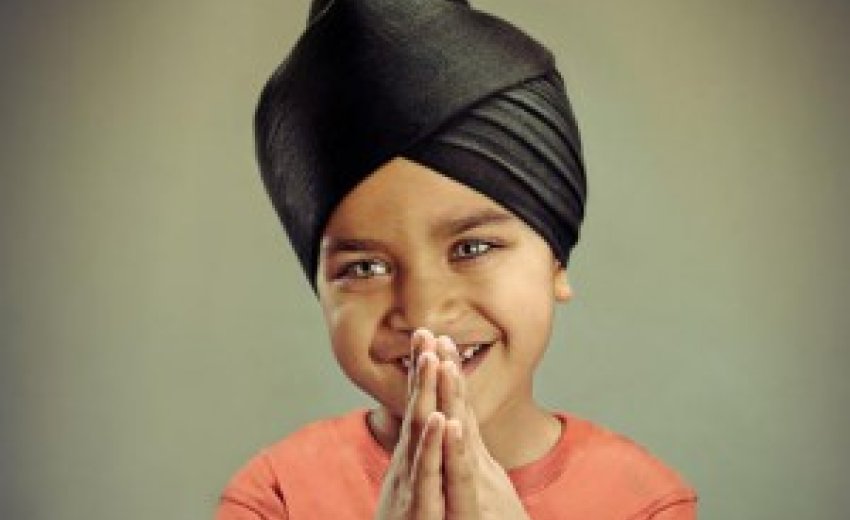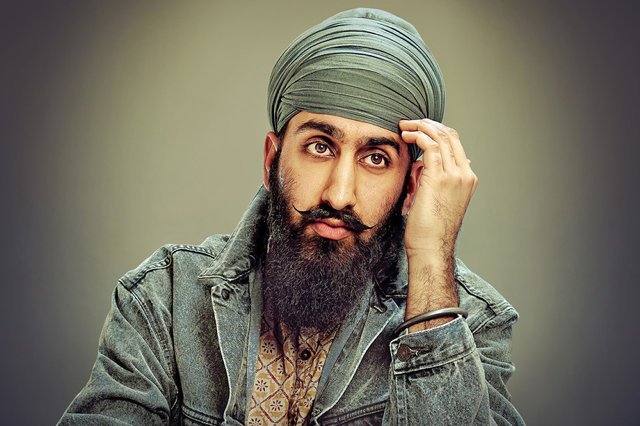A pair of London photographers document British Sikh men of all ages, in all their bearded, be-turbaned, Kirpan-wielding glory.
 |
| Ishtmeet Singh Phull - Student London-based photographer duo Amit and Naroop, who were raised on a mixture of Western and traditional Sikh values, were intrigued by how trendy beards had become among the hip secular set. moreAmit and Naroop |
|
In contemporary hipsterdom and among Hollywood’s leading men, the beard is a fashion statement. But in the Sikh religion, a resplendent beard is a symbol of spiritual deference and discipline. London-based photographer duo Amit and Naroop, who were raised on a mixture of Western and traditional Sikh values, were intrigued by how trendy beards had become among the hip secular set. It inspired them to do a photography project documenting contemporary Sikh men; they would focus on the symbolism of those men's beards and turbans. “We wanted men who wore their turban in their own style and with beards that had character,” Naroop tells Co.Design.
Speaking to their subjects, the photographers were struck by the pride they took in their beards and turbans. Specifically, Sikhs’ beards symbolize the belief that God made humans in perfection, and that they shouldn’t alter his choice in facial hair. Then there are the turbans, many in bright colors and prints, worn to protect the uncut hair and to guard the spiritual opening Sikhs believe resides at the top of the head. Some of their subjects pose with a Kirpan, a dagger that symbolizes a Sikh's duty to come to the defense of those in peril. Baptized (and practicing) Sikhs wear these daggers on their body at all times. “Some of the younger Sikh men told us how their younger years were spent drinking, smoking, and getting into trouble,” Naroop says. “But when they embraced Sikhism, grew their hair, and wore a turban, they no longer needed their previous false physical pleasures as Sikhism gave them everything they needed on a deeper spiritual level.” A few of the older Sikh men told stories of having to cut their hair when they first came to England--just to be accepted by a xenophobic culture and to get jobs to feed their families. The photographer duo found Sikhism's compatibility with modern science attractive. As they were growing up, “religion was never forced on us,” Naroop says. “We find following its teachings in the modern world feels natural and not prohibitive,” he says, and emphasizes, “Singh is a project close to our heart. It represents our identity as British born photographers and our Punjabi, Sikh roots.” Back the project here. [Photos by Amit and Naroop] |
---------------------------------
Related Article:
The Striking Men Of Sikhism Get Their Due
The Huffington Post | Mallika Rao
06/11/2014: The surname Singh is so prevalent around the world that Canada used to ban immigrants from keeping it, claiming the name was too common to process quickly.
Today, it’s a loaded identifier: violence against those who bear the name Singh -- men who belong to the religion known as Sikhism -- has escalated since the attacks of September 11, so much so that the FBI has devoted a branch to investigating such crimes.
 |
| Still from Kickstarter. |
Given the visual nature of the Sikh identity, the photo above is a long time coming. It's part of The Singh Project, a new undertaking by British photographers Naroop Singh Jhooti and Amit Amin. The series features tight-cropped portraits of Sikh men, intended to “highlight the subjects,” according to a video on the project’s Kickstarter page.
The subjects are both diverse and narrowly chosen. Some are young, donning leather and jeans. Others look like jolly grandfathers in a Tinkle cartoon. Several, young and old, brandish the traditional Sikh knife, or kirpan.
 |
| Still from Kickstarter. |
|
|
| “But we felt a sense of pride,” Jhooti says. “It was great to see these men come into our studio. Their pride in their identity was so strong that it reinforced our belief in our religion.” |
All, however, are followers of the Sikh tenet forbidding the cutting of hair out of reverence for the body. Accordingly, many Sikh men -- and some brave women -- tend to sport luxurious facial hair. Their uncut head hair is hidden by a turban. The regal look, often confused by the uninformed for an Islamic one, befits the faith’s commonest name: Singh comes from the Sanskrit word simha, which means lion (think Disney’s “Simba”).
In the Kickstarter video, creators Jhooti and Amin discuss how embarking on the project has changed their view of Sikhism. Both are Sikhs, but neither devout enough to look the part:
“But we felt a sense of pride,” Jhooti says. “It was great to see these men come into our studio. Their pride in their identity was so strong that it reinforced our belief in our religion.”
The project also calls to mind the work of Waris Ahluwalia, a Sikh man-about-town who’s recently stirred up press. Known to his admirers simply as Waris, the designer/model/gadfly made national headlines last year, when a Gap ad he was featured in across the U.S. drew anti-Muslim vandalism.
The Singh Project is poised to pick up where Ahluwalia left off, broadcasting the unique look of Sikh men to the general public, with an exhibit of oversized prints.
“And of course,” Amin adds in the video, “plenty of tea and samosas at the launch party.”
|

